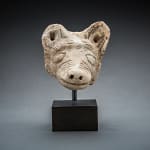Siro-Hittite Terracotta Sculpture of a Head of a Dog, 2000 BCE - 1500 BCE
Terracotta
10.8 x 11.4 cm
4 1/4 x 4 1/2 in
4 1/4 x 4 1/2 in
LO.1217
Further images
The Hittites were an Asia Minor population who inhabited a number of city-states scattered across the mountainous plateau of Anatolia. They were the first people in the area to mine...
The Hittites were an Asia Minor population who inhabited a number of city-states scattered across the mountainous plateau of Anatolia. They were the first people in the area to mine and use iron, and by 1600 BCE they had firmly established themselves making Hattusa (today's Bogazkale, or Bogazkoy) the capital of their kingdom, before expanding to control most of the surrounding region. The ancient art of the Hittite kingdom - notably its architecture and relief sculpture - was produced largely during this imperial phase which reached its height during the 14th century BC. During this period the Hittites controlled an area that included most of the Anatolia, Upper Mesopotamia (Iraq) as well as Syria and Lebanon. Although Hittite art has its own particular style, it was undoubtedly influenced by Sumerian art - the leading cultural strain within Mesopotamian art - and also by Egyptian art, not least because of the Egyptian’s supreme craftsmanship at stone cutting and carving. Assyrian art, too, would eventually have an important part to play but only several centuries later. The Hittite empire collapsed about 1180, but the Hittites reappeared in several "Neo-Hittite" city-states - which they controlled in collaboration with Aramaeans and other populations - some of which endured until around 750 BCE. Our main source of knowledge about Hittite culture derives from the archeological discovery of royal archives in the Hittite capital of Hattusa. These archives consisted of hundreds of stone tablets inscribed in Mesopotamian cuneiform letters, written in the Semitic language of Babylonia and Assyria. One of the most revealing tablets (written in Akkadian script and dating to c.1275-1220 BC) contains correspondence from the Egyptian Queen Nefertari (wife of Ramses II) to the Hittite Queen Puduhepa, presently preserved in the Museum of Anatolian Civilizations, in Ankara.







